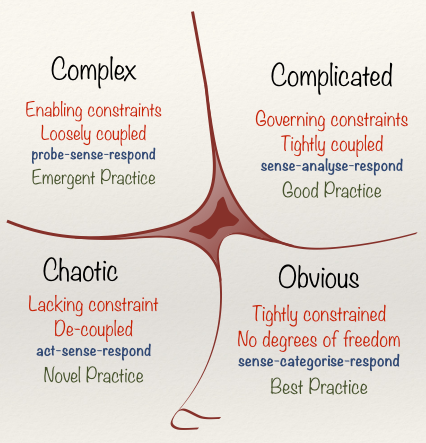
Today software has moved away from a syntactic role, towards a more semantic role. Any software decision percolates through to affect the business in a real sense, and hence it matters more than ever to for every business to keep software/IT-dept in-loop while making any sort of decision. Such a decision making must be based on a strong conceptual framework(s), and one such framework happens to be the Cynefin framework.
Introduction

Cynefin framework as defined by its creator, Dave Snowden is inherently a sense-making model. First look at the diagram, and it seems like any other categorization model comprising a 2x2 matrix. However, in a categorization model, the framework precedes the data. Categorization model is good for exploitation, but it is pretty poor for exploration or during periods of change. A sense-making model is one where the data precedes the framework, and the framework itself emerges from the data in a social process.
The Framework

1. Simple/Obvious Systems
This is an ordered system, where cause-and-effect relationships exist. Hence, these are predictable systems where effects can be determined in advance, and thus processes can be repeatable. Here the decision model is Sense-Categorise-Respond. We see what is coming in, we make it fit in a category, and based on category decide what to do. Here, we apply ‘Best Practice’, a phrase which is legitimate in these systems but illegitimate in other systems
2. Complicated Systems
This is also an ordered system, where cause and effect relationships exist. However, these cause-and-effect relationships are not self-evident. Thus there needs to be either:
a. An analytical method for making a decision
b. The existence of an expert who built expertise within that domain who can make the right decisions
Hence, the decision model is Sense-Analyse-Respond. Here there is no such thing as ‘Best Practice’; but rather a set of ‘Good Practices’ of which the expert chooses one in decision making.
3. Complex Systems
These are systems without causality, with light constraints on agents where agents modify the system. Hence, the decision model is Probe-Sense-Respond. Here we conduct safe failed experiments; we don’t do failsafe design. If an experiment succeeds, then we amplify it; if it fails, we dampen it. We have an unpredictable emergent outcome, where cause and effect are only obvious in hindsight. This outcome is a new way of doing things, it’s novel; it may be some combination of older processes, but it’s unique.
4. Chaotic Systems
These systems are the ones where if we enter deliberately, it’s for innovation; but if we enter accidentally, then we need to stabilize the position quickly. Here, no cause and effect relationships can be determined, and hence the decision model is Act-Sense-Respond. We move very quickly to stabilize a situation, and any practice/outcome is completely novel in terms of the way things work.
5. Disorder
The central space (Disorder) is the key and represents the state of not knowing which of the approach one should be pursuing. This is where we are most of the time. The trouble then is we interpret the situation according to our personal preference for action!
The Simple-Chaotic Boundary

Another key aspect of the Cynefin framework which is frequently missed off by people who try and over-simplify it is that the boundary between Simple and Chaotic is different from the other boundaries. It’s actually referred as a cliff or a symbolic type of wave at the bottom. The principle here is that if one starts to believe that things are simple, one starts to believe that they’re ordered. Thus, one starts to believe in one’s own myths, and one starts to believe that past success means one is invulnerable to future failure. All the other boundaries allow for transitions, but for this one falls over the edge!
The impact in software
Having worked in the software industry for 10 years, I’ve seen startups (and at times bigger companies) make the mistake of being in the simple domain for too long. They effectively move into the complacent zones. At times they under-value the importance introduction of new processes, adapting to new technology stacks, investing in data science activities, technology strategy-n-philosophy, and RnD. This complacent zone is the boundary between simple and chaotic, and in time one falls over the edge in a crisis, recovery from which is very expensive. One of the goals at SentienceIQ is to help businesses by adopting effective processes to software development, being up-to-date with new technology stacks, using their data effectively to seek valuable business insights and effective application of frameworks like the Cynefin framework in their technology journey.
Peace ✌️
